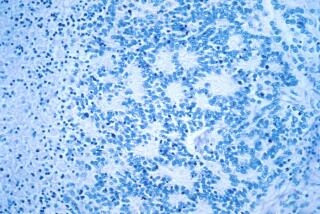New Treatment Cuts Infections in Some Young AIDS Patients
- Share via
WASHINGTON — A new treatment can significantly reduce the number of life-threatening bacterial infections in some children with the AIDS virus, resulting in fewer hospitalizations and an improved quality of life, the National Institutes of Health announced Thursday.
A controlled clinical study demonstrated that monthly intravenous doses of immunoglobulin increased the time that children spent free from bacterial infections and reduced the number of bacterial infections they suffered, said the National Institute of Child Health and Human Development, a division of the national institutes.
NIH officials said it was unclear whether the treatment could be effective in adults.
Immunoglobulin, derived from the blood of healthy donors, contains concentrated antibodies, which are proteins produced by the body to fight infections.
The AIDS virus damages the body’s immune system, making the individual vulnerable to a range of infections.
As of Nov. 30, 2,734 AIDS patients under the age of 13 were reported to the federal Centers for Disease Control. However, experts estimate that, for every child reported as having AIDS, two to 10 children may be HIV-infected, NIH said.
Between March 1, 1988, and Oct. 31, 1990, the child health institute enrolled in the clinical trial 372 children between the ages of 2 months and 12 years. They were categorized by previous infection history and by their count of T4 helper cells. The T4 cells are the immune system cells that are the primary target of HIV.
In the group, 115 had counts below 200 , which is an indication of a seriously impaired immune system. A count of 800 is considered the base line for a normal immune system. A second group of 257 children had counts of 200 or above.
One hundred and eighty-five of the children received the drug, and 187 received a placebo, or worthless solution. All of the patients received the regular standard care for HIV infection, which can include the antiviral drug AZT and/or treatments to prevent the onset of pneumocystis carinii pneumonia, a common AIDS-related illness.
The drug worked well only for the group of children with T4 cell counts higher than 200, NIH said.
In the group of children with T4 cells higher than 200, the treatment “significantly prolonged bacterial infection-free time,” which was 583 days for the treated group, compared to 221 days for the placebo group, NIH said. For children with T4 cell counts of less than 200, the duration of infection-free days was similar in both the drug-treated group and the placebo group, 282 days and 255 days respectively, NIH said.






